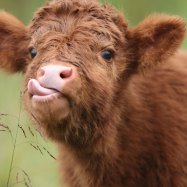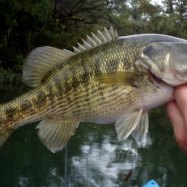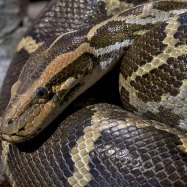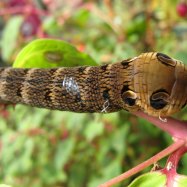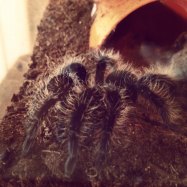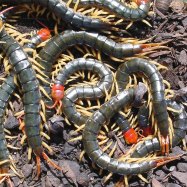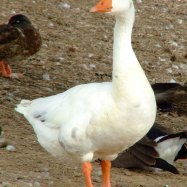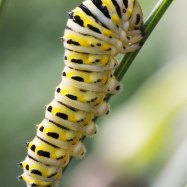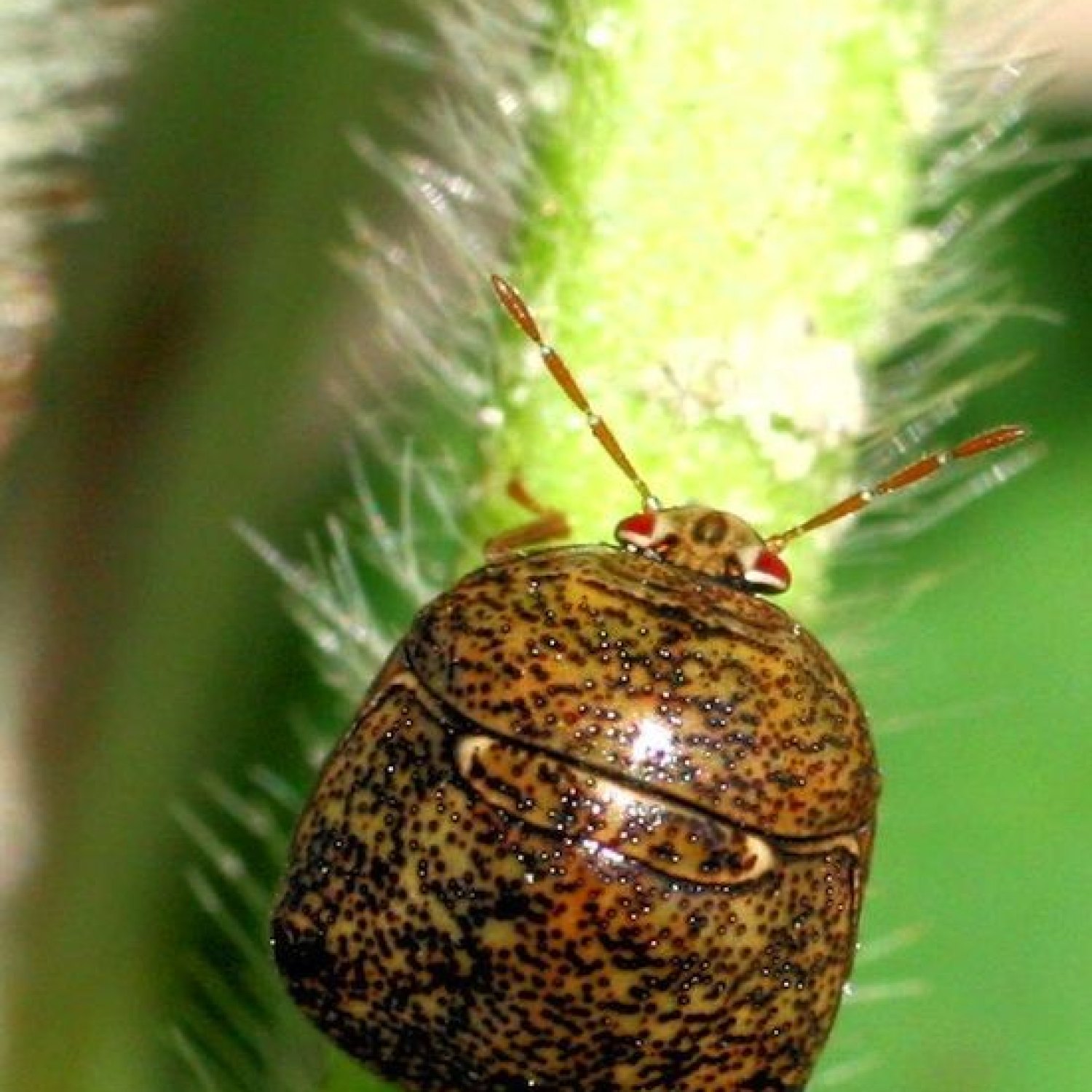
Kudzu Bug
4 to 6 mm
The Kudzu Bug, also known as the bean plataspid, is a small, shield-shaped insect that measures 4 to 6 mm in length. This invasive species has been spreading quickly in the Eastern and Southeastern United States, damaging crops and ornamental plants. It belongs to the family Plataspidae and is easily recognizable by its brownish color and white spots. Farmers and gardeners should be vigilant in monitoring and controlling the spread of this pest. #KudzuBug #InvasiveSpecies #PestControl
Animal Details Summary:
Common Name: Kudzu Bug
Kingdom: Animalia
Habitat: Fields, gardens, and forests
The Invasive yet Fascinating Kudzu Bug: Everything You Need to Know
If you're living in the Eastern and Southeastern United States, you may have come across a little insect that is causing quite a stir in the agricultural world – the Kudzu Bug. This small yet invasive bug has been gaining attention due to its massive population growth and impact on agriculture. But, did you know that this little bug has a fascinating backstory and a unique set of characteristics? In this article, we will delve into the world of the Kudzu Bug, also known as Megacopta cribraria, and uncover its intriguing traits.The Origin of the Kudzu Bug
Let's start with the basics – where did this bug come from? As its scientific name suggests, the Kudzu Bug is native to East Asia Kudzu Bug. It is believed to have originated from Japan, where it was first described in the late 1800s. However, as the years passed, this bug made its way to other Asian countries, including China and Korea.The Introduction to North America
The Kudzu Bug was first recorded in the United States in October 2009 in the state of Georgia. It is believed that the bug was introduced to the States unintentionally, most likely by stowing away in shipping containers or agricultural products. By 2010, the bug had spread to several other states, including South Carolina, North Carolina, and Virginia.Habitat and Distribution
The Kudzu Bug has a wide range of habitats, including fields, gardens, and forests, making it a versatile insect. However, as its name suggests, this little bug has a particular affinity for a specific plant – the kudzu vine. This vine, which is native to Japan, is an invasive species in the United States, and the Kudzu Bug follows suit. It primarily feeds on the sap of the kudzu plant, causing significant damage to its host Kinabalu Giant Red Leech.In terms of geographical distribution, the Kudzu Bug can be found in most Eastern and Southeastern states of the United States, including Alabama, Tennessee, and Kentucky.
Physical Characteristics of the Kudzu Bug
The Kudzu Bug belongs to the Animalia kingdom and is classified under the phylum Arthropoda, and the class Insecta. It falls under the order Hemiptera and the family Plataspidae. This bug is olive-green to brown in color, with a shield-shaped body, measuring between 4 to 6 mm in length.The Kudzu Bug has a rigid and flattened body, with a characteristic triangular-shaped head. Its wings are a mix of brown and black, giving it a mottled appearance. The hind legs of this insect are long and stick-like, while the front legs are shorter and thicker. The Kudzu Bug also has a tiny snout, which it uses to pierce into plants and suck out their sap.
Feeding Habits of Kudzu Bugs
The Kudzu Bug feeds on plant sap, making them herbivorous insects. As mentioned earlier, they have a particular affinity for the kudzu plant; hence, they are considered a pest as they can cause massive damage to this plant. However, they have also been found feeding on other legumes, such as soybeans, bean crops, and wisteria.The feeding process of the Kudzu Bug involves piercing the plant with its sharp snout and injecting digestive enzymes, which help to break down the plant's tissue. It then sucks out the plant's sap, causing damage to the plant's vascular system. This feeding process is not only harmful to the plants but can also lead to their death, especially in the case of the kudzu plant.
The Kudzu Bug's Impact on Agriculture
The introduction of the Kudzu Bug in the United States has caused a significant impact on the agricultural industry. As mentioned earlier, these bugs are voracious feeders and can cause significant damage to crops. In the case of the kudzu plant, which is already considered an invasive species, the Kudzu Bug's presence further accelerates its growth, making it even more challenging to control.The Kudzu Bug's impact is not only restricted to the kudzu plant but also extends to other legumes, including soybeans. These bugs can cause yield losses for soybean crops, resulting in financial losses for farmers. Moreover, the Kudzu Bug's rapid population growth has made it challenging to control their spread, making it a persistent threat to agriculture.
Controlling the Kudzu Bug Infestation
Given the Kudzu Bug's significant impact on agriculture, several measures have been taken to control their infestation. These include cultural, biological, and chemical control methods.Cultural control methods involve the removal of the kudzu vine, which is the primary host for the Kudzu Bug. Researchers have found that by removing the kudzu vine, there is a significant decrease in the population of the Kudzu Bugs. However, this method is not entirely effective as these bugs have been found on other legumes as well.
Biological control involves introducing natural predators to feed on the Kudzu Bugs. This method has shown some promising results, with researchers introducing a parasitic wasp that feeds on the Kudzu Bug's eggs. However, this method is still under study, and its effectiveness is yet to be determined.
Chemical control methods involve using insecticides to kill the Kudzu Bugs. However, this method can be harmful to other beneficial insects that feed on these bugs, and hence, its usage must be monitored carefully.
The Role of Natural Language Processing in Studying Kudzu Bugs
As the Kudzu Bug continues to impact agriculture, researchers are turning to technological advancements to study these bugs better. One of the most promising tools is Natural Language Processing or NLP. This branch of Artificial Intelligence focuses on understanding and analyzing human language, making it a valuable tool in analyzing data from scientific research and studies.NLP can help researchers sift through vast amounts of data, including research papers, studies, and reports, to gain insights into the behavior, population growth, and control methods of the Kudzu Bug. It can also assist in understanding the impact of these bugs on different crops and plants, enabling researchers to develop more effective control measures.
Moreover, NLP can also help in predicting the spread of the Kudzu Bug in different areas, providing valuable insights for farmers and policymakers. By using NLP, researchers can also identify any gaps or inconsistencies in the data, leading to more accurate and reliable results.
Final Thoughts
The Kudzu Bug is an invasive yet fascinating insect that has caused widespread concern in the agricultural world. Its impact on the kudzu plant and other legumes is a serious threat to the agriculture industry, and efforts are being made to control its infestation. However, as researchers continue to study these bugs, advancements in technology, such as NLP, are providing valuable insights and playing a crucial role in understanding and managing the Kudzu Bug population.

Kudzu Bug
Animal Details Kudzu Bug - Scientific Name: Megacopta cribraria
- Category: Animals K
- Scientific Name: Megacopta cribraria
- Common Name: Kudzu Bug
- Kingdom: Animalia
- Phylum: Arthropoda
- Class: Insecta
- Order: Hemiptera
- Family: Plataspidae
- Habitat: Fields, gardens, and forests
- Feeding Method: Herbivorous
- Geographical Distribution: Native to East Asia, introduced to North America
- Country of Origin: East Asia
- Location: Eastern and Southeastern United States
- Animal Coloration: Olive-green to brown
- Body Shape: Shield-shaped
- Length: 4 to 6 mm
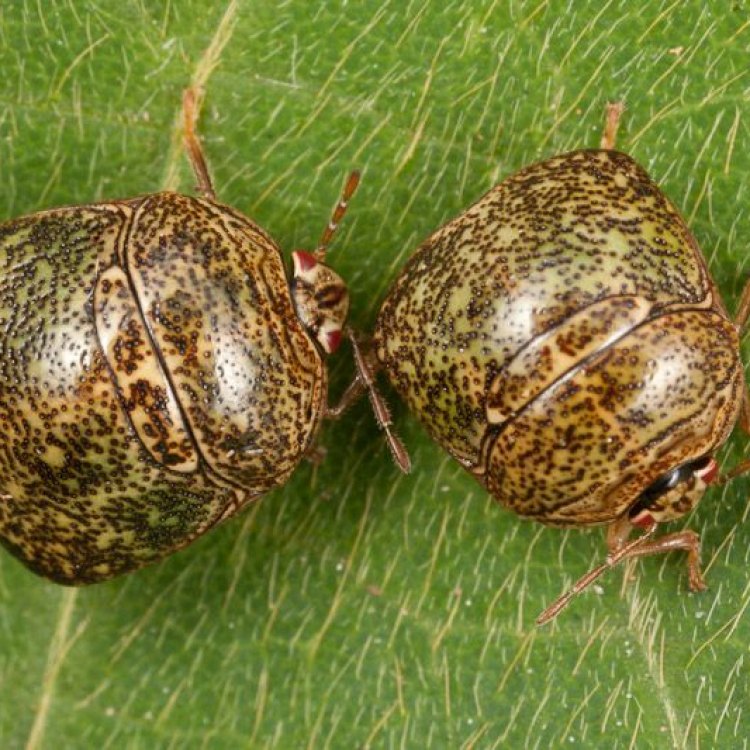
Kudzu Bug
- Adult Size: Small
- Average Lifespan: 1 year
- Reproduction: Sexual
- Reproductive Behavior: Mating occurs during warmer months
- Sound or Call: Not known to produce sounds
- Migration Pattern: No long-distance migrations
- Social Groups: Solitary
- Behavior: Aggregate in large groups
- Threats: None significant
- Conservation Status: Not evaluated
- Impact on Ecosystem: Can be a nuisance to farmers and gardeners
- Human Use: None significant
- Distinctive Features: Distinctive shield-like shape and coloring
- Interesting Facts: Feeds almost exclusively on kudzu plants
- Predator: Not known
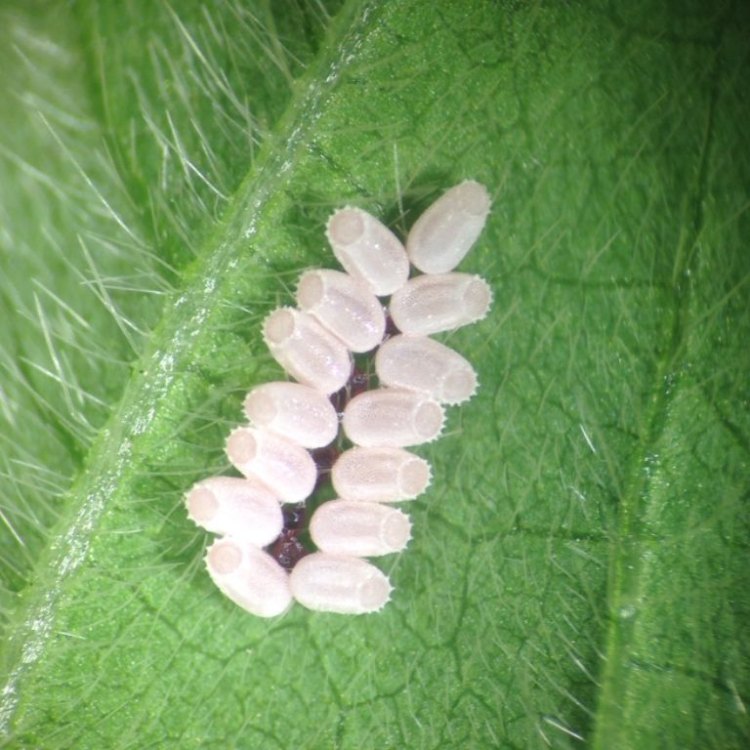
Megacopta cribraria
The Prolific and Mysterious Kudzu Bug: A Tiny Insect with Huge Implications
The world is full of fascinating creatures, some of which can leave us in awe with their incredible abilities and distinct features. However, there are some lesser-known species that may not get the recognition they deserve. The Kudzu Bug, also known as the Lablab Bug or the Bean Plataspid, is one such species that holds a great deal of mystery and intrigue. Although small in size, this tiny insect has created quite a buzz in recent years due to its distinct features and potential impact on the ecosystem PeaceOfAnimals.Com.Appearance and Lifecycle
The Kudzu Bug, scientifically known as Megacopta cribraria, is a small insect that belongs to the stink bug family. It measures between 3-6 mm in length, making it a relatively small insect in comparison to other stink bugs. Its distinct shield-like shape and brown and green coloring make it easily recognizable in the wild.On average, the Kudzu Bug has a lifespan of one year, with adults emerging in early spring and laying eggs throughout the summer. Unlike some insects that reproduce asexually, the Kudzu Bug follows a sexual reproduction cycle. This means that both male and female insects are required for mating to occur.
Reproductive Behavior
Mating in Kudzu Bugs occurs during the warmer months, usually from May to October. The males will emit a scent to attract females, and after mating, the females will lay their eggs in tight clusters on the underside of kudzu leaves. Each egg cluster can contain up to 500 eggs, which is an astounding number for an insect of its size King Vulture.The eggs will hatch within a week, and the nymphs will go through five molting stages before reaching adulthood. During this time, they will feed on kudzu plants, which are a staple in their diet. Interestingly, the Kudzu Bug is one of the few known insects to feed almost exclusively on kudzu plants, hence its name.
Social Behavior and Threats
Kudzu Bugs are solitary insects, meaning they do not form social groups or colonies. However, they have been observed to aggregate in large groups, especially during the winter months when they seek shelter in buildings or homes. These aggregations can be quite overwhelming, with large numbers of Kudzu Bugs gathering in one place.When it comes to threats, the Kudzu Bug seems to have very few natural predators. They may be eaten by birds or some other insects, but they do not have any significant predators that pose a threat to their population. Therefore, their conservation status has not been evaluated as they are not considered to be a species at risk.
Impact on Ecosystems
Despite their small size and seemingly harmless behavior, the Kudzu Bug can have a significant impact on the ecosystem. As mentioned earlier, these insects feed solely on kudzu plants, which are invasive and aggressive vines that can quickly cover large areas of land. This plant is known to choke out native vegetation and have detrimental effects on the environment.The introduction of the Kudzu Bug in the United States in the 2000s brought hope that it would help to control the spread of kudzu plants. However, researchers have found that these insects may not be as effective in reducing the plant's growth as initially thought. In fact, their feeding may even stimulate the plant's growth, leading to further invasion.
Human Use and Interesting Facts
While the Kudzu Bug may not have any significant benefit to humans, these insects do have some interesting facts worth mentioning. For one, they do not produce any sounds or calls, making them a quiet and discreet species. Additionally, they do not engage in any long-distance migrations, making them relatively stationary and localized.Another fascinating fact about the Kudzu Bug is that their saliva has natural anticoagulant properties, which has led to research on its potential medical applications. However, no significant breakthroughs have been made yet.
Mysterious Predators
With their shield-like shape and brown and green coloration, Kudzu Bugs may seem like easy prey for predators. However, there is very little information on the predators that may feed on these insects. Researchers have observed that they may be eaten by birds, spiders, and some other insects, but there is no substantial evidence to support this. It remains a mystery as to why these insects do not have any significant predators, but it could be due to their distinct coloring, making them blend in with their surroundings.The Need for Further Research
Despite being around for over two decades, there is still much that remains mysterious about the Kudzu Bug. As previously mentioned, there is limited information on their predators, as well as their exact impact on the kudzu plant and other vegetation. Therefore, there is a growing need for further research on this unique and intriguing insect.One area of interest is their behavior and reproductive patterns. Although it is known that they mate during the warmer months, it is unclear what specific environmental cues trigger mating. This information could help in predicting their population growth and control.
Additionally, more research should be done on their relationship with the kudzu plant. While their introduction was intended to help control the plant's growth, it has been observed that their feeding may actually stimulate the plant's growth. Understanding this complex relationship is crucial in developing effective conservation strategies for both the Kudzu Bug and the kudzu plant.
Conclusion
In conclusion, the Kudzu Bug may be a small insect, but it holds a great deal of mystery and potential impact on the ecosystem. From its distinct features and behavior to its relationship with the invasive kudzu plant, there is still much that we do not know about this tiny creature. Its introduction in the United States has sparked both curiosity and concern, making it a species that deserves further research and attention. With more studies and observations, we may be able to unravel the mysteries of the Kudzu Bug and better understand its role in our ecosystems. Only then can we develop effective strategies to manage its population and potential impact.
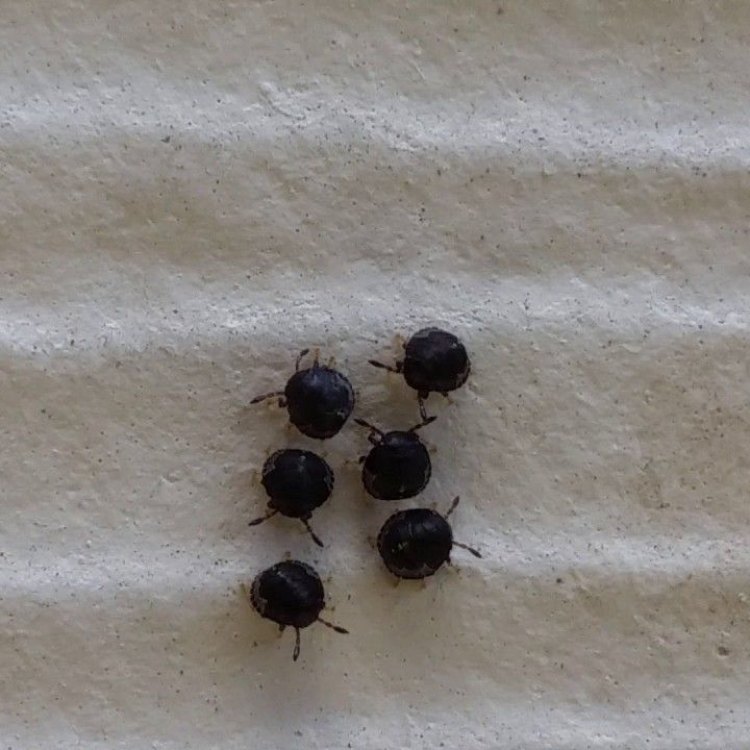
The Invasive yet Fascinating Kudzu Bug: Everything You Need to Know
Disclaimer: The content provided is for informational purposes only. We cannot guarantee the accuracy of the information on this page 100%. All information provided here may change without prior notice.

